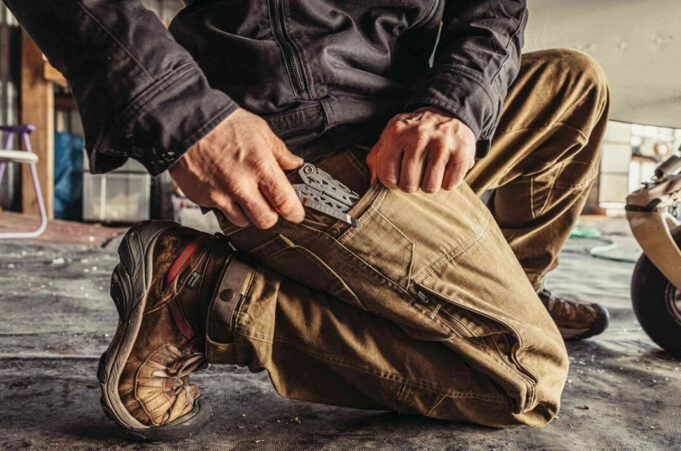Tactical pants are highly favored by law enforcement officers, military personnel, and outdoor enthusiasts due to their resilience, practicality, and comfort. However, the fit of tactical pants is crucial in determining their effectiveness and comfort during use. This article explores how tactical pants should fit to guarantee optimal performance and comfort.
Waist and Hips
The waistband of tactical pants should encircle your waist comfortably, neither too tight nor too loose. A helpful guideline is to measure your waist and add an inch for a relaxed fit. Furthermore, tactical pants should provide ample space in the hips and thighs, allowing for ease of movement and flexibility.
Length
Tactical pants should be sufficiently long to cover your entire ankle bone but not so lengthy that they bunch up at the bottom. They should also exhibit a slight break at the front of the shoe to prevent them from riding up as you walk or run.
Inseam
The inseam of tactical pants should fit comfortably between your legs without being excessively tight or loose. When seated, the pants should not tug at the crotch or impede movement. A reliable way to measure the inseam is by measuring the distance from the crotch to the bottom of the ankle bone.
Legs
The legs of tactical pants should wrap comfortably around your calves without being overly tight or loose. Additionally, the pants should allow for unhindered movement, particularly around the knees, to enable running, jumping, and other physical activities.
Pockets
Tactical pants usually feature multiple pockets designed for storing equipment, tools, and various items. These pockets should be thoughtfully positioned for easy access and not be so extensive that they add unnecessary bulk. Moreover, pockets should be deep enough to securely hold items in place.
Material
The material used for tactical pants plays a significant role in their performance, durability, and comfort. Manufacturers utilize a variety of materials and fabric blends to cater to the diverse needs of users, including law enforcement officers, military personnel, and outdoor enthusiasts. Here, we delve deeper into the different materials commonly used in tactical pants:
- Ripstop Fabric: Ripstop fabric is a popular choice for tactical pants due to its resistance to tearing and ripping. This material is typically made from nylon, polyester, or a blend of both, with a unique weaving pattern that creates a reinforced grid structure. The reinforcement ensures that any potential tears do not expand, contributing to the fabric’s longevity and durability.
- Cotton Canvas: Cotton canvas is a classic, heavy-duty fabric with a tight weave that provides a sturdy, yet comfortable feel. It offers excellent breathability, making it a suitable choice for warmer climates or extended periods of wear. However, cotton canvas is not as resistant to water or stains as other materials, which can be a drawback in some situations.
- Polyester/Cotton Blend (PolyCotton): PolyCotton is a blend of polyester and cotton fibers, combining the benefits of both materials. This blend offers the breathability and comfort of cotton with the added durability, water-resistance, and quick-drying properties of polyester. PolyCotton tactical pants are highly versatile and are favored for their balance of performance and comfort.
- Nylon: Nylon is a synthetic material known for its lightweight, durable, and water-resistant properties. Its resilience and low moisture absorption make it ideal for use in wet conditions or environments with high humidity. However, nylon is not as breathable as cotton or some other natural fibers, which can be a drawback in warmer temperatures.
- Stretch Fabrics: Some tactical pants incorporate stretch fabrics, such as elastane (Spandex) or mechanical stretch materials, into their design. These fabrics enhance flexibility and freedom of movement, ensuring that the pants do not restrict the wearer during physically demanding tasks. Stretch fabrics are often blended with other materials, like cotton or polyester, to maintain the durability and functionality of the tactical pants.
- Teflon Coating: Many tactical pants are treated with a Teflon coating, which adds a layer of protection against water, stains, and dirt. This coating helps maintain the pants’ clean and professional appearance while also extending the life of the fabric.
The materials used in tactical pants vary based on the specific needs and preferences of the user. Key factors to consider when selecting the right material include durability, breathability, water-resistance, and flexibility. By understanding the characteristics of different materials, you can make an informed decision and choose tactical pants that meet your performance requirements and comfort preferences.
Conclusion
In summary, tactical pants should fit snugly around the waist and hips, offer sufficient room in the thighs and hips for movement, be long enough to cover the ankle bone, have a comfortable inseam, and wrap comfortably around the legs. Additionally, the pants should feature strategically placed pockets and be constructed from durable, breathable materials. By adhering to these guidelines, you can ensure that your tactical pants fit correctly and deliver their maximum potential.












